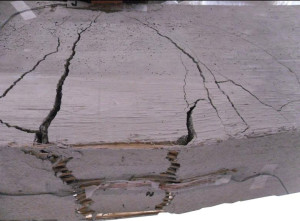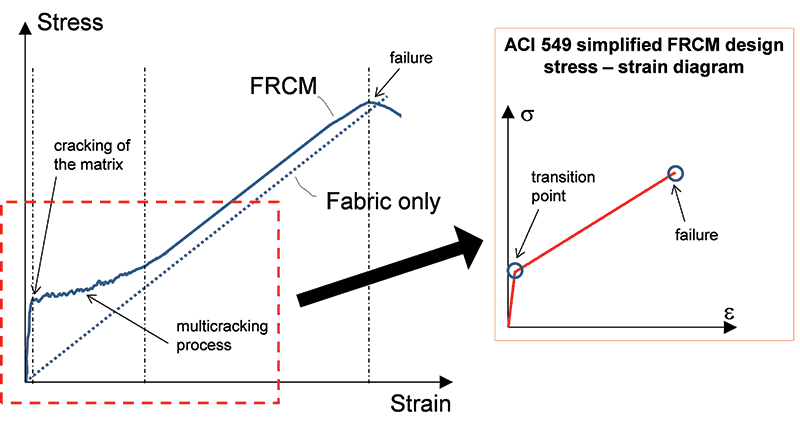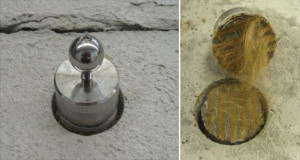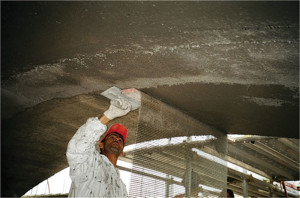The Second Generation of Externally-Bonded Composite Systems for Strengthening of Concrete and Masonry Structures
After overcoming the initial growing pains (insufficient experience, track record, and knowledge overshadowed by overzealous euphoria with “magic” material capabilities), externally-bonded fiber reinforced polymer (FRP) systems have become one of the preferred technologies for repair and strengthening of concrete and masonry structures in the United States. FRP systems have features such as high tensile strength, light weight, relative ease of installation, and resistance to corrosion, which make them attractive to the repair industry. However, FRP also has limitations, which can preclude their use in some applications. For instance, high temperatures compromise the efficiency of FRP systems, FRP applications are limited on moist surfaces or at low temperatures, and FRP systems typically act as a vapor barrier.
These drawbacks are all related to the epoxy matrix used to embed and bond the fibers. Thus, substituting the epoxy matrix with a cementitious matrix appeared to be the most reasonable solution to improve the overall performance of externally-bonded composite systems. This new generation of composite systems is known as fabric reinforced cementitious matrix (FRCM). FRCM developed as an evolution of ferrocement, where the mortar matrix is reinforced with open meshes of continuous dry fibers. In the literature, FRCM is also known as Textile Reinforced Concrete (TRC), or Textile Reinforced Mortar (TRM). The first use of TRC and TRM was reported in Europe in the late 1990s in new construction applications such as permanent formworks elements, facades, tanks and containment.
The FRCM System
Constituent Materials
FRCM systems consist of fibers embedded in a cementitious matrix. The function of the fibers is to carry tensile stresses. In FRCM composite systems, the fiber sheets or fabrics that are typically used in FRP are replaced with open fabric meshes in which the rovings are assembled in at least two directions (generally orthogonal) by means of weaving, knitting, tufting, or braiding. “Closed” fiber fabrics are not suitable because the cementitious matrix cannot penetrate and impregnate the fiber filaments. However, the open structure of the fabric meshes provides higher matrix-reinforcement interface area which is needed to achieve the composite action between the matrix and the reinforcing system. Typically, the mesh openings do not exceed 0.75 inches. The rovings are typically coated with resin to improve the bond to the mortar matrix, enhance the long-term durability and improve the load transfer among the roving filaments. The fabric meshes are typically made of carbon, alkali-resistant glass, basalt, polymeric fibers (such as Polyparaphenylene benzobisoxazole, PBO), or hybrid systems.
The function of the matrix is to encapsulate and protect the fibers, and transfer stresses from the concrete or masonry substrate to the fibers. Stress transfer is accomplished through bonding between the substrate and the matrix, and the mechanical interlock between the fabric and the matrix. The composition of the cementitious matrix is very important and crucial for the performance of the FRCM system. The mortar should be non-shrinkable and workable, to be easily applied with a trowel and to penetrate the fabric mesh openings, and viscous to apply on vertical surfaces. In addition, the mortar rate of workability loss should be low to allow for multiple layers of reinforcement.
Both hydraulic and non-hydraulic cements can be used. Finely graded sands (grain size smaller than 0.02 inch) help improve the workability of the fresh mix and the impregnation of the fabric mesh. The water-to-mortar ratio by weight typically ranges between 15% and 25%. The mortar mix can include chopped fibers to reduce the plastic shrinkage cracking. Organic compounds can also be used to control the hardening rate and the workability of the fresh mix, to improve the bond to the fabric mesh, and to enhance the mechanical properties. Their content is generally limited to be less than 5% by weight of cement to obtain a fire-proof matrix.
Mechanical Properties
The performance of FRCM systems is highly dependent on their tensile strength and bond strength. The FRCM tensile behavior can be differentiated in three phases (Figure 1). In the first phase, the load is carried primarily by the cementitious matrix until cracking. In the second phase, the matrix undergoes a multicracking process resulting in transfer of stresses from the reinforcing fabric to the matrix, with some debonding at the fabric-matrix interface. At the third phase, the composite system behaves almost linearly until failure occurs due to the progressive rupture of the roving fiber filaments and debonding of the fabric from the matrix. In this phase, the load is carried almost exclusively by the fabric. The modulus of elasticity is influenced by the fiber volume content.
As a comparison, FRP has a single-phase linear elastic tensile behavior until failure. The ultimate tensile strain in FRP is limited by the ultimate strain of the fibers.
The tensile properties of FRCM cannot be generalized, and each system should be evaluated individually. However, the tensile failure generally occurs at a strain level of approximately 50% of the ultimate tensile strain of the fiber filament. Table 1 provides a summary of the mechanical properties of several commercially available fabrics.
The bond strength of FRCM to the substrate material is difficult to quantify as it depends on the type of fibers, fiber sizing, mesh layout, composition of the matrix, substrate properties, and quality of the surface preparation. Unlike FRP, the FRCM fibers are not impregnated; therefore, pull-off tests on concrete substrates typically show the fracture failure within the fabric reinforcement or at the fabric-matrix interface (Figure 2).
Physical Properties
FRCM systems offer better performance under elevated temperatures, humidity, and ultraviolet radiation than FRP systems. In contrast to FRP, FRCM is inherently noncombustible and can be used unprotected. Combined with their noncombustibility and nontoxic characteristics, FRCM systems are a good option for strengthening when resistance to high temperatures is required.
Durability
FRCM for structural strengthening applications is a relatively new material. The results of durability testing is still limited. However, based on available tests, FRCM is expected to overcome some of the issues that are typically found in FRP because the cementitious matrix performs better than the polymeric matrix in moist and chemically aggressive environments. Moreover, research studies have proven the longevity of alkali-resistant (AR) glass fiber within the cementitious matrix.

Figure 3. Slippage of the fabric within the cementitious matrix in proximity of a flexural crack in concrete beam. Courtesy of the University of Miami.
Applications in Structural Strengthening
FRCM systems are a viable option for flexural and shear strengthening of concrete and masonry members. In general, the strength increases in reinforced concrete beams or slabs, and unreinforced masonry walls strengthened with FRCM systems are comparable to those of similar elements strengthened with FRP. However, their overall behavior is slightly different. In the case of FRP-strengthened elements, failure is typically due to the debonding from the concrete or masonry substrate. This type of brittle failure does not generally occur with FRCM-strengthened elements, where less brittle “unzipping” failures typically occur due to progressive slippage of the fibers within the cementitious matrix or delamination at the fiber-matrix interface. Fiber slippage across a flexural or shear crack is caused by the gradual loss of bond between the fibers and the matrix and/or by the gradual rupture of the fibers (Figure 3). Fiber delamination generally occurs when multiple layers of FRCM reinforcement are used and is preceded by large fiber slip (Figure 4).

Figure 4. Delamination of the fabric within the cementitious matrix. Courtesy of the University of Miami.
FRCM systems can also be used to provide confinement to concrete columns to increase their axial strength. The effectiveness of FRCM is highly dependent on the number of confining layers and the tensile strength of the cementitious matrix, which determines whether the behavior is controlled by delamination of the fabric within the matrix or fiber rupture. At this time, limited research is available to assess the feasibility of FRCM systems for seismic retrofitting of columns.
In the case of masonry strengthening, FRCM systems can be used on concrete and clay masonry walls. Cementitious matrices of FRCM are more compatible with masonry substrates. Masonry elements are many times subject to continued exposure to moisture migrating through the wall thickness. Polymeric matrices of FRPs can act as thermohygrometric barriers which can cause moisture to remain trapped within the masonry and lead to debonding of the strengthening material. The porosity and vapor permeability of cementitious matrices of FRCMs are similar to the masonry substrate and moisture does not become trapped within the masonry substrate. Figure 5 illustrates the strengthening with FRCM of the masonry arches of a church in Italy.
ACI 549 Design Guidelines
Earlier this year, the American Concrete Institute (ACI) published ACI 549.4R13 – Guide to Design and Construction of Externally Bonded FRCM Systems for Repair and Strengthening Concrete and Masonry Structures, a document developed by Committee 549. For design purposes, the ACI 549 Guide idealizes the FRCM tensile stress-strain curve as bilinear with a bend-over point (or transition point) corresponding to the intersection obtained by continuing the initial and secondary linear segments of the response curve (Figure 1). The initial linear segment of the curve corresponds to the FRCM uncracked linear elastic behavior and it is characterized by the uncracked tensile modulus of elasticity. The second linear segment, which corresponds to the FRCM cracked linear elastic behavior, is characterized by the cracked tensile modulus of elasticity.
The design approach for flexure and shear strengthening considers an effective usable strain of FRCM, which represents a strain limit that globally accounts for the loss of bond. ACI 549 identifies three different types of bond failures: cohesive, when the failure occurs in the substrate material; adhesive, when the failure occurs at the interface between the FRCM and the substrate material; and, adhesive, when the failure is within the FRCM at the interface between the reinforcing fabric and the matrix. The first two types of failure are also observed in FRP, while the third failure is specific to FRCM. Depending on the amount of FRCM, this limit is typically in the range of 50 to 70% for concrete, and 30 to 40% for masonry. Once the effective strain is defined, the design procedure of FRCM strengthening is similar to the design procedure using FRP.
The ACI 549 design guide recommends that the FRCM system manufacturer perform tests meeting the acceptance criteria (AC434-13) established by the International Code Council Evaluation Services (ICC-ES) to obtain the mechanical, physical, and durability properties to be used in design. The qualification test plan defined by AC434-13 includes the definition of the following: matrix drying shrinkage, matrix void content, tensile properties, bond strength, interlaminar shear strength, long-term properties, and freezing and thawing resistance. A material system that has been evaluated according to these acceptance criteria and has received a product research report from ICC-ES can be accepted by code officials as building code compliant.
Construction
FRCM systems are installed using the hand layup method. The surface preparation requires surface roughening and leveling, and moistening to achieve the saturated surface dry condition. Surface preparation of masonry substrates typically does not require roughening. The installation procedure is simple. Mixing and application of the cementitious matrix is similar to conventional hand-applied repair mortars used in concrete repairs. First, a thin layer of cementitious matrix (in the range of 0.2-inch thick) is uniformly applied (troweled- or sprayed-applied) on the substrate, then the fabric mesh is pressed into the matrix. Finally, a second thin layer of cementitious matrix is applied on top of the mesh. Multiple layers of mesh can be applied following the same procedure.
The cementitious matrix in the first mesh layers does not need to be fully cured in order to apply subsequent layers. Primers, fillers, and/or protective coatings may be required for some substrates or types of matrices. Temperature at the time of installation can affect the cementitious matrix. Thus, high temperatures (in the range of 95-130°F) may reduce the workability, while low temperatures (in the range of 39-43°F) may slow down setting considerably.
Final Thoughts
FRCM systems are currently being introduced in the structural repair and rehabilitation industry as a new, effective strengthening technology. Due to their superior performance at high temperatures, better compatibility with the substrate, and improved durability, FRCM systems are a good alternative to FRP systems. It is expected that the use of FRCM systems to strengthen existing concrete and masonry structures will become a common tool for design professionals and contractors with the availability of the ACI 549 design guide.▪




